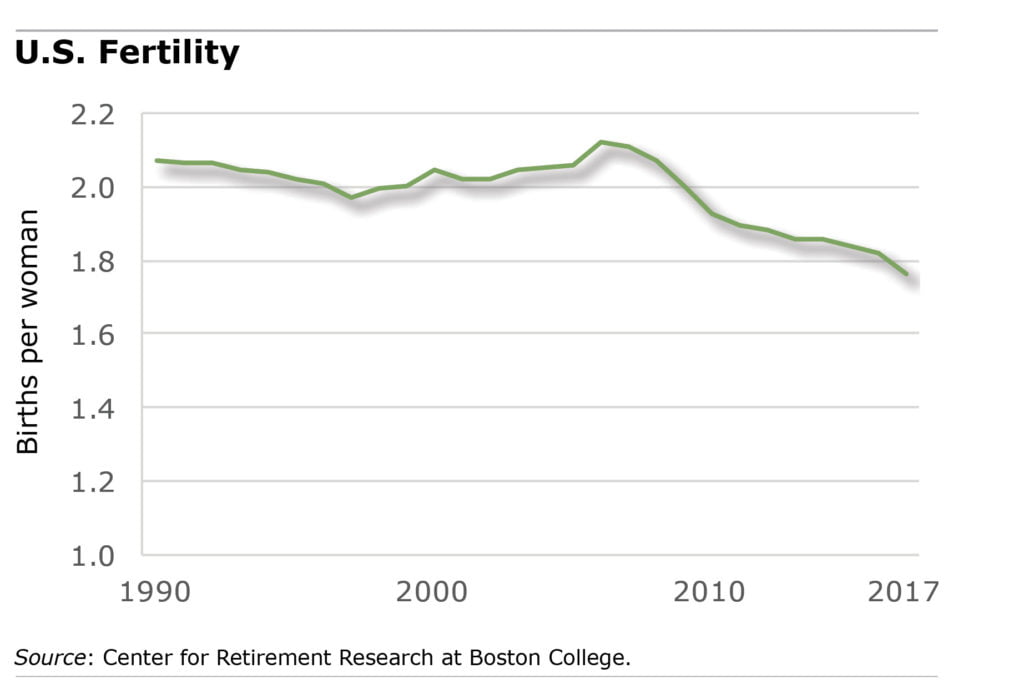
US Fertility Falls in Midst of Recovery
 When the economy is expanding and more people are working and earning more, they can afford to have more babies.
When the economy is expanding and more people are working and earning more, they can afford to have more babies.
But that time-tested connection between the economy and fertility seems to be broken. During the recovery that followed the 2008-2009 recession and continues today, the U.S. fertility rate has dropped quite a bit.
Lower fertility is of interest to retirement experts because it has serious implications for our aging population. AARP’s Public Policy Institute predicts a decline in the number of family members and friends available in the future to care for the elderly. Fewer babies also mean fewer workers will be paying into Social Security, in the absence of an increase in immigration.
Of course, fertility rates in developed countries like the United States, Germany, and Japan are far below the post-World War II baby boom. But the very recent decline in this country is striking. The total fertility rate, the best measure of current fertility, is 1.76 births per woman. This is well below the rate of 2 births per woman a decade ago.
A study by researchers at the Center for Retirement Research at Boston College identified four structural changes that are pulling the birth rate down.
First, the growing ranks of women with a college education are changing the calculation about children: they are having fewer of them. Second, college-educated women have better job options, and their rising earnings, relative to men, during the period analyzed have increased the financial cost of being a mother, reducing fertility to a lesser extent.
Another change is that women who do not belong to a religious congregation are also having fewer children. Their birth rates are lower than they are for women who do belong to a congregation, according to data for 2013 through 2015 – for example, the non-members have one less child than fundamentalists, who have the highest fertility.
Finally, the researchers looked at changes in the Hispanic population, which historically has had higher fertility than the nation’s blacks and whites. Since 2007, however, Hispanics’ fertility rate has been dropping, coinciding with the fall in immigration after the Great Recession.
Part of the reason for this decline is that U.S.-born Hispanics have lower fertility than immigrants from Latin America, so the Hispanic population overall is having fewer children. The black population has closely tracked white fertility for years and both continued downward during the recovery too.
The researchers conclude that the decline in U.S. fertility may no longer simply be economic fallout. Sweeping changes in the U.S. population are having a larger effect.
Squared Away writer Kim Blanton invites you to follow us on Twitter @SquaredAwayBC. To stay current on our blog, please join our free email list. You’ll receive just one email each week – with links to the two new posts for that week – when you sign up here.
Comments are closed.







Have you correlated the decline in birth rates with the lack of increase in median wages for the 18 to 35 year old age group?
No Larry but that’s an interesting idea! I will pass this on to our researchers.
Thanks for reading the blog.
Kim
I recall this article from a couple of years ago, indicating that not only does the fertility rate go down as incomes go up, but – at the individual level – rich families tend to have fewer children than poor families. That might be contrary to the stagnant median wage theory.
I recall this article from a couple of years ago, indicating that not only does the fertility rate go down as incomes go up, but – at the individual level – rich families tend to have fewer children than poor families. That might be contrary to the stagnant median wage theory.
Just to point out that the relationship shown is across countries, not across households within countries.
The missing middle class (lack of wage increases and wage declines) is also the first thing I thought of when I read this.